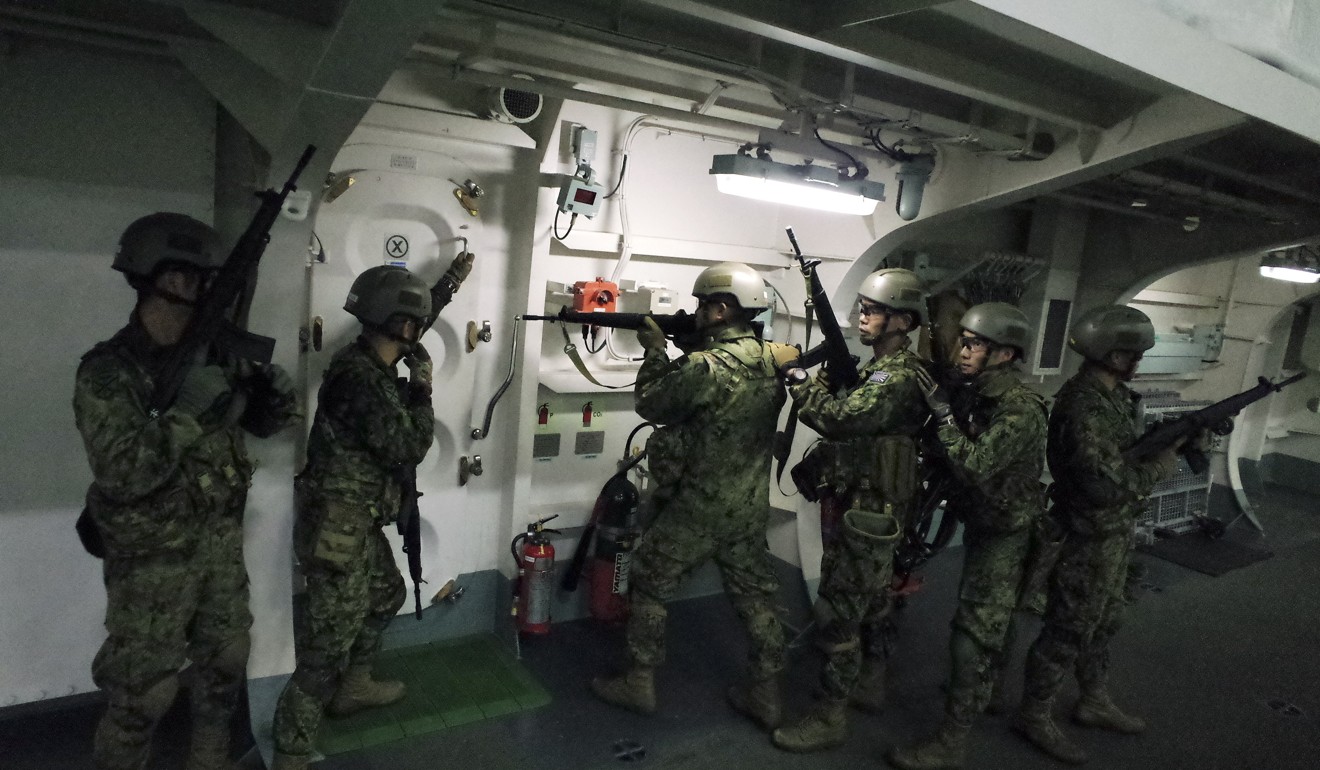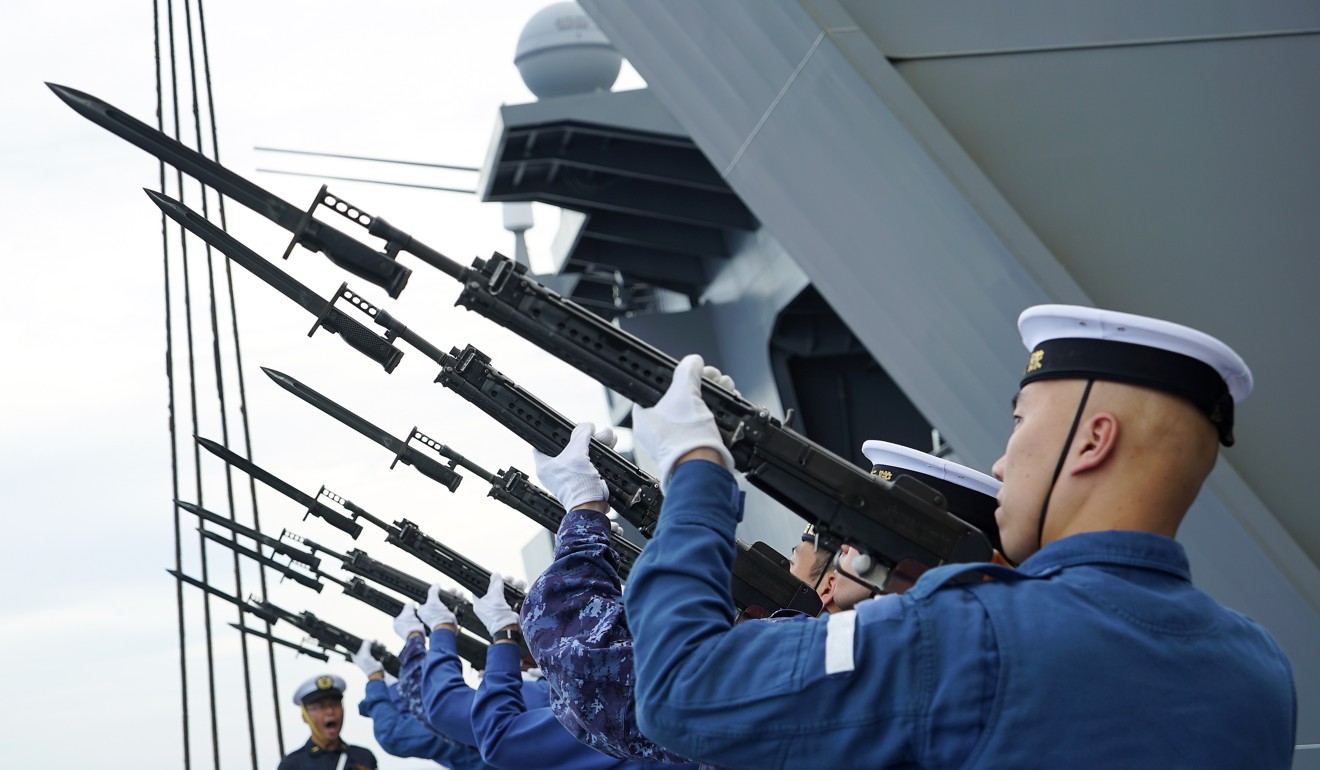
Japan flexes its military muscle on edge of South China Sea with joint naval drills involving warships, marines
- Prime Minister Shinzo Abe has long sought to strengthen the country’s military might by amending its pacifist constitution
- The drills with the US and other countries come at a time of prolonged tensions over China’s sweeping territorial claims

One of Japan’s largest warships, the helicopter carrier Izumo, offers a glimpse of where its military is headed: for the first time, troops from a newly formed amphibious brigade of Japan’s army took part in an extended naval deployment.
The Izumo left Subic, a former US naval base in the Philippines, at the end of a two-month deployment in the Indo-Pacific region at a time of prolonged tensions involving China’s sweeping territorial claims in and around the South China Sea. The carrier, along with the destroyers Murasame and Akebono, just finished a series of drills with the United States and other countries.

Japan’s ability to project military power beyond its borders is severely constrained by the commitment to pacifism and rejection of use of military force in conflict enshrined in its post-World War II constitution, though in 2015 it was reinterpreted to allow the use of force in defending itself and its allies.
Prime Minister Shinzo Abe has made amending the constitution to allow the military greater leeway one of his lifetime goals. President Donald Trump has sought to help that cause, calling repeatedly for Japan to do more to defend itself under its alliance with the US
In May, Japan conducted its first quadrilateral exercise with France, the US and Australia in the Bay of Bengal. France deployed its flagship nuclear-powered aircraft carrier, the FS Charles de Gaulle, while the United States sent a missile destroyer, the William P Lawrence. Other drills have included Canada, India, Malaysia, Vietnam, Brunei and the Philippines.
Japan is preparing to reconfigure the Izumo to accommodate US stealth fighters, including F-35Bs, after announcing it would purchase 42 of its own. The aircraft are designed to operate with short take-offs and vertical landings, such as on carriers.
The purchase underscores Japan’s growing role in its post-war alliance with the US
“To incorporate what was not originally in the design, or something new that had not even been thought of, I think this would require research into many areas, otherwise it wouldn’t go well,” said Captain Katsuyoshi Motoyama, the Izumo’s commanding officer.
Yasukazu Tanaka of the Amphibious Rapid Deployment Brigade, similar to the US Marines, said the recent exercises were meant to deepen coordination between them and ground troops to facilitate use of the carrier for transporting troops to front lines in the future.

Since the Izumo can accommodate both air and sea transport, “there are great possibilities for us to conduct amphibious operations,” he said, though he and all others involved emphasised that the ground and marine troops conducted no joint exercises.
Ground troops are still exploring how best to operate on longer missions, where regulations limit use of live-fire weapons on board. Troops practised emergency first aid response and trained on the flight deck and in the aircraft carrier hangar deck, at times using guns made of rubber in battle scenarios.
China has been expanding its military presence to press home its determination to defend its claim to virtually the entire South China Sea in the face of challenges by the US and its allies, unnerving many in the region.
The defence ministry says Japan’s air force scrambled fighter jets 999 times in 2018, the second highest number since it began defending its airspace in 1958. Of that number, 64 per cent were responses to Chinese aircraft.

The US Navy and others have angered Beijing by repeatedly sailing their ships close to Chinese-occupied islands to assert what they say is the right to freedom of navigation. Beijing also has installed advanced weapons systems at several disputed locations, including seven islands it built by piling sand and concrete on top of coral atolls.
Some of those sites are now equipped with airstrips, radar and missile stations, expanding China’s ability to monitor and potentially control activity by other militaries in the region.
So far, encounters have been peaceful, but all sides are concerned about the potential for miscalculations that could spark conflict.
During its five-day voyage, Izumo skirted near the so-called nine-dash line marking China’s territorial claims while conducting its last few exercises with navies from Brunei and the Philippines.

Japan’s navy also hosted a training programme for young representatives from Southeast Asian nations, with lectures on international maritime law, humanitarian and disaster relief programmes, and exercises in navigation and communications. Most participants were officers in their 20s and 30s.
“Especially with the territorial and boundaries part, I think that would be vital information for us,” said Muhammad Danial bin Matyussof, a junior lieutenant in the Brunei navy. “We have neighbouring boundaries with Malaysia and Vietnam, so it could provide insight every time we do patrols.”
While the backdrop of the exercises was evident, given China’s rising profile, “This Indo-Pacific deployment is not an operation that is aimed at any one specific country,” said Hiroshi Egawa, commander of Escort Flotilla One.